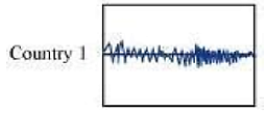|
SECTION – A
|
|
|
Q. No.
|
Questions
|
Marks
|
|
1.
|
Which group of animals does not give us a food product?
(a) Honeybee and goat
(b) Cow and buffalo
(c) Silk moth and oyster
(d) Fish and sheep
|
1
|
|
2.
|
What do we call the storage sacs of the cell?
(a) Plastids
(b) Vacuoles
(c) Mitochondria
(d) Ribosomes
|
1
|
|
3.
|
What term is used for the stoppage of the menstrual cycle?
(a) Ovulation
(b) Menstruation
(c) Menarche
(d) Menopause
|
1
|
|
4.
|
The sac containing the testis is called the
(a) Testicle
(b) Scrotum
(c) Epididymis
(d) Oviduct
|
1
|
|
5.
|
Coal burns in air to form mainly
(a) Carbon dioxide
(b) Carbon monoxide
(c) Carbon
(d) Water
|
1
|
|
6.
|
Exhaustible natural resources in nature are
(a) Limited
(b) Unlimited
(c) Abundant
(d) Not available
|
1
|
|
7.
|
Maximum light emitted by a candle comes from the
(a) Red zone
(b) Yellow zone
(c) Blue zone
(d) Orange zone
|
1
|
|
8.
|
Tools meant for cutting and piercing always have
(a) A long handle
(b) Smooth edges
(c) Sharp edges
(d) All of the above
|
1
|
|
9.
|
Carbon monoxide when inhaled binds to hemoglobin in the blood and forms a compound
called
(a) Decarboxyhemoglobin
(b) Oxyhemoglobin
(c) Carboxyhemoglobin
(d) Carboxylhemoglobin
|
1
|
|
10.
|
Which of the following is not a chemical method to purify water?
(a) Use of bromine
(b) Use of Chlorine
(c) Use of Hydrogen peroxide
(d) Filtration
|
1
|
|
11.
|
Rahul wants to purchase a house in a country. He has to choose a place among four
countries. The seismographic readings of four countries are shown in the given figure.
Among the given countries, which country should he select for living?
(a)

(b)

(c)

(d)

|
1
|
|
12.
|
The frictional force exerted by a fluid is called
(a) Brag
(b) Drag
(c) Drab
(d) Thread
|
1
|
|
13.
|
The production of partial vacuum by the removal of air is called
(a) Function
(b) Suction
(c) Air function
(d) Pumping
|
1
|
|
14.
|
The given diagram shows four positions of the Moon in its orbit around the Earth.

The full moon phase is represented by the position labeled
(a) I
(b) II
(c) III
(d) IV
|
1
|
|
15.
|
Following are pairs of various constellations and the number of prominent stars in them.
Choose the incorrect alternative.
(a) Orion $-3$
(b) Cassiopeia $-5$
(c) Ursa major $-7$
(d) Leo major $-9$
|
1
|
|
SECTION B
|
|
|
16.
|
What is the relation between deforestation and obtaining fuel?
|
2
|
|
17.
|
|
2
|
|
i.
|
How is the zygote formed in sexual reproduction?
|
|
|
ii.
|
Where does the development of a baby take place in humans?
|
|
|
18.
|
Name the four stages $A, B, C$ and $D$ shown in the

|
2
|
|
19.
|
Justify the statement: Coal is formed by carbonisation.
|
2
|
|
20.
|
How does the quantity of $mathrm{CO}_2$ in the atmosphere rise and become excessive?
|
2
|
|
21.
|
Select the optical aids among the following:
Telescopic aids, Bifocal lenses, Tactual aids, Auditory aids, Contact lenses, Tinted lenses.
|
2
|
|
22.
|
What do understand by sources of sound? Give any two examples.
|
2
|
|
SECTION C
|
|
|
23.
|
Draw a labelled diagram of the human ovum.
|
4
|
|
24.
|
List any four cell organelles found in animal cells and state their functions.
|
4
|
|
25.
|
Differentiate between plant and animal cells.
|
4
|
|
26.
|
Thermoplastics become soft on heating but thermosetting plastics do not. Explain the statement with the help of examples and draw labelled diagram also.
|
4
|
|
27.
|
What are the different ways to extinguish fire? Explain.
|
4
|
|
28.
|
|
4
|
|
i.
|
Discuss the working of a sprinkler system of irrigation.
|
|
|
ii.
|
Draw a well-labelled diagram of a hoe used to remove weeds.
|
|
|
29.
|
When a wooden block is moving down an inclined plane what is the direction of the
frictional force acting on the block? Explain.
|
4
|
|
30.
|
|
4
|
|
i.
|
Why is a ray of light considered as an idealisation?
|
|
|
ii.
|
What are the uses of periscopes?
|
|
|
31.
|
|
4
|
|
i.
|
Why do the stars appear to us like point objects?
|
|
|
ii.
|
What is a meteorite? How does it help the scientists?
|
|
|
SECTION D
|
|
|
32.
|
|
5
|
|
i.
|
Name any two organisms which reproduce by budding.
|
|
|
ii.
|
What is a bud?
|
|
|
iii.
|
Draw a neat diagram to show the process of budding in Hydra.
|
|
|
33.
|
Give reasons for the following:
|
5
|
|
i.
|
A matchstick can light a tiny splinter of wood but not a big log of wood.
|
|
|
ii.
|
Forest fires occur during the hottest summer days.
|
|
|
iii.
|
Dry leaves catch fire easily but it is difficult to burn a heap of green leaves.
|
|
|
34.
|
|
5
|
|
i.
|
What effects does an electric current produce when flowing through a conducting
solution?
|
|
|
ii.
|
A child staying in a coastal region tests the drinking water and also the sea water with
his tester. He finds that the compass needle deflects more in the case of seawater.
Can you explain the reason?
|
|


